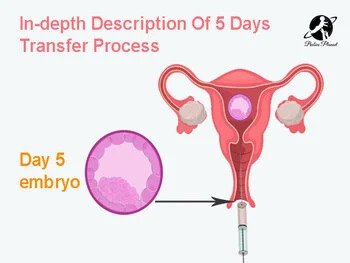Yes, when you will explore all the day 6 Blastocyst success stories the In Vitro Fertilization System (IVF) works great. IVF is the ultimate solution for those couples who can’t naturally get pregnant.
This process is also known as blastocyst transfer. In this process, an ovum cell is acquired from the female body and cultured in a lab to grow into a larger size.
And then, the ovum turns into a 6-day-old cultured blastocyst in the lab. After that, the blastocyst is transferred back to the womb.
Well, it’s the 21st century and there is a solution to that. IVF!
Day 6 Blastocyst Success Stories

Here are five day 6 blastocyst success stories of couples who found success with a blastocyst transfer:
1. After years of trying to conceive on their own and multiple failed IVF cycles, Sarah and John decided to try a blastocyst transfer. They were thrilled when it worked on the first try and they welcomed a healthy baby girl nine months later.
2. Tina and her husband had been trying to conceive for over five years when they decided to give blastocyst transfer a try. They were ecstatic when it worked on the second try and they welcomed a healthy baby boy six months later.
3. After multiple failed IVF cycles, Mary and her husband decided to give blastocyst transfer a try. They were overjoyed when it worked on the first try and they welcomed a healthy baby girl nine months later.
4. After years of trying to conceive on their own and multiple failed IVF cycles, Lisa and her husband decided to give blastocyst transfer a try. They were thrilled when it worked on the first try and they welcomed a healthy baby boy six months later.
5. After multiple failed IVF cycles, Karen and her husband decided to give blastocyst transfer a try. They were elated when it worked on the second try and they welcomed a healthy baby girl nine months later.
Day 6 blastocyst transfer success rates
The success rate with a 5-day-old embryo (blastocyst) is about 51.7% right now.
Now, the question remains,” is day 6 blastocyst transfer more successful than day 5 blastocysts?”.
According to the data that is collected from over 1,000 patients, a day 6 blastocyst success stories are considered as higher success rate than day 5 blastocysts in the blastocyst transfer process. According to current data, the success rate of getting pregnant by a day 6 blastocyst transfer is about 54.1%.
So, we can say that the day 6 blastocyst transfer process has provided better chances for women to get pregnant and deliver healthy babies.
Compared to a day 5 blastocyst transfer process, the success rate of the day 6 blastocyst transfer process is higher because embryos get bigger by the 6th day of fertilization
As a result, it retains more strength to survive after that transfer process.
Also, because a day 6 blastocyst stays in the lab for 6 days, it can be monitored and taken proper care of for a longer period.
As a result, the process of choosing a healthy blastocyst for the transfer process is much easier with day 6 blastocysts.
Day 6 embryo transfer implantation (Steps by steps)
In the United States, the infertility rate among the women are rising. Even after the positive ovulation test women oftentimes not get pregnant.
This is why the in-vitro fertilization system was developed to curb the issue of infertility. It is an artificial system of fertilizing the ovum cell and the sperm cell.
The embryo can be transferred when it’s 3 to 6 days old. Up until 2012, embryos that were transferred to the female body used to be 3 to 4 days old. Using that method, the success rate of getting pregnant is satisfactory.
But, for the last 9 years, the doctors have tried to implant 5-day-old embryos into the female womb.
Related post: 7dp5dt bfn (big fat negative) on First response early pregnancy test

As a result, the success rate of the embryo surviving and the female being pregnant has massively increased.
This system works in 5 steps, shown as below:
1. Applying Medication To The Female
In general, women create one perfect ovum cell per month. Now, for the process of IVF, women are treated with medication, so they can create 4 to 5 perfect ovum cells in a particular month.
2. Collecting The Egg:
Then, the ovum egg is acquired from the female body by a small surgery. In the process of surgery, the female is fully sedated and the egg is extracted from her body through the vaginal passage.
Also, on the same day of this surgery, sperm is collected from the male.
3. Fertilization Of Egg And Sperm:
At this point, the egg and sperm that were acquired from the female and male are combined in a laboratory environment. This process is called fertilization. To ensure a higher success rate, advanced technologies such as Intracytoplasmic Sperm Injection are utilized in this step.
4. Culturing Of The Embryo:
Now, doctors will culture the embryo that has been born as a result of fertilization. Culturing the embryo will cause it to divide into 2 cells and then into 4 cells and so on. Following this sequence, the embryo will grow into at least 100-120 cells.
5. Transference Of Embryo:
When the embryo is 5 to 6 days old, it’s then called a blastocyst. At this point, the blastocyst is transferred to the female womb. After the blastocyst has been transferred to the womb, the female will have to wait 10 days. After 10 days of wait-time, the female will be tested to verify if she is pregnant or not.
Do All Types Of Blastocysts Successfully Implant In The Womb?
No, not all types of blastocysts are not successfully implanted in the womb.
Some studies have suggested that “successful embryo implantation depends on many factors including genetic anomalies or disorders“.
The main reason to have the following things:
1. Acceptance of the female womb
https://www.ncbi.nlm.nih.gov/pmc/articles/PMC4563383/
2. Quality of the sperm and egg
3. Age of the female womb, etc.
By considering these 3 parameters, the success may turn out failure.
There is no definite numeric percentage of the success rate of blastocysts being successful in implanting in the womb. But, the possibility of success can be increased by constant monitoring and proper care of the blastocyst.
But, doctors encourage trying out the implantation, no matter what the success rates are. It’s because successful implantation is not a phenomenon that can be fully predicted.
So, it is always recommended that people try out the IVF, no matter how much the chances of successful implantation results might be.
What Happens After A Successful Implementation?
After the blastocyst has been transferred to the womb, it stimulates the womb to grow and develop the cells of the placenta. When the placenta cells are fully developed, the blastocyst gets the facility to receive nutrients and oxygen from the placenta (from the mother’s body).
As a result, the boosted energy and nutrients in the blastocyst make it divide at a faster rate. And, it develops very quickly into a larger-sized blastocyst. That, in turn, results in the creation of the human baby in the womb.
Frequently Asked Questions:
1. Is the IVF process painful for the female?
No, absolutely not. The modern-day IVF process is not painful at all. The female is always sedated during the surgery of blastocyst transference and acquisition of the egg. That’s why, if you are having difficulty getting naturally pregnant, there’s no point in being afraid to try out the IVF process.
2. What food items should I avoid when I am going through IVF?
During the IVF process, it is recommended to avoid red meat and excess sugar. Furthermore, doctors also forbid the intake of refined grains and highly processed foods.
On the other hand, doctors encourage the intake of avocado, nuts, seeds, extra virgin olive oils, and healthy fats.
3. How many days of rest should a female take after going through IVF blastocyst transference?
The blastocyst transference process involves a small-scale surgery. During the surgery process, only a small incision is done on the female body. That’s why it is okay to just take 2 days of rest after the blastocyst transference surgery.
But, for further assurance, We recommend that you consult your doctor to know the appropriate amount of rest that you have to take after your IVF process.
The Bottom Line:
Finally, I have to say that getting pregnant is something that all women cherish. That’s why it is always recommendable to take IVF no matter what the risks are or the success rates might be.
As we all know, fortune favors the brave. So, we encourage you to go ahead and try out the IVF without worrying about the outcome. Best of luck!!
Sources:
- Kaye, L., Will, E. A., Bartolucci, A., Nulsen, J., Benadiva, C., & Engmann, L. (2017, July). Pregnancy rates for single embryo transfer (SET) of day 5 and Day 6 blastocysts after cryopreservation by vitrification and slow freeze. Journal of assisted reproduction and genetics. Retrieved October 27, 2022, from https://www.ncbi.nlm.nih.gov/pmc/articles/PMC5476550/#:~:text=Ongoing%20pregnancy%20rates%20from%20day,6%20(p%20%3D%200.68).
- Thaijaroen, P., Benjaponwattana, P., Jiaranai, P., Marshall, J., & Tiewsiri, K. (2015, September). AB095. comparison pregnancy of day 6 fresh blastocyst and day 5 frozen-thawed blastocyst transfer following array comparative genome hybridization (acgh). Annals of Translational Medicine. Retrieved October 27, 2022, from https://www.ncbi.nlm.nih.gov/pmc/articles/PMC4563383/
- Editor. (2022, July 1). Early signs of pregnancy. American Pregnancy Association. Retrieved October 22, 2022, from https://americanpregnancy.org/pregnancy-symptoms/early-signs-of-pregnancy/
- Kaye, L., Will, E. A., Bartolucci, A., Nulsen, J., Benadiva, C., & Engmann, L. (2017, July). Pregnancy rates for single embryo transfer (SET) of day 5 and Day 6 blastocysts after cryopreservation by vitrification and slow freeze. Journal of assisted reproduction and genetics. Retrieved October 27, 2022, from https://www.ncbi.nlm.nih.gov/pmc/articles/PMC5476550/#:~:text=Ongoing%20pregnancy%20rates%20from%20day,6%20(p%20%3D%200.68).
